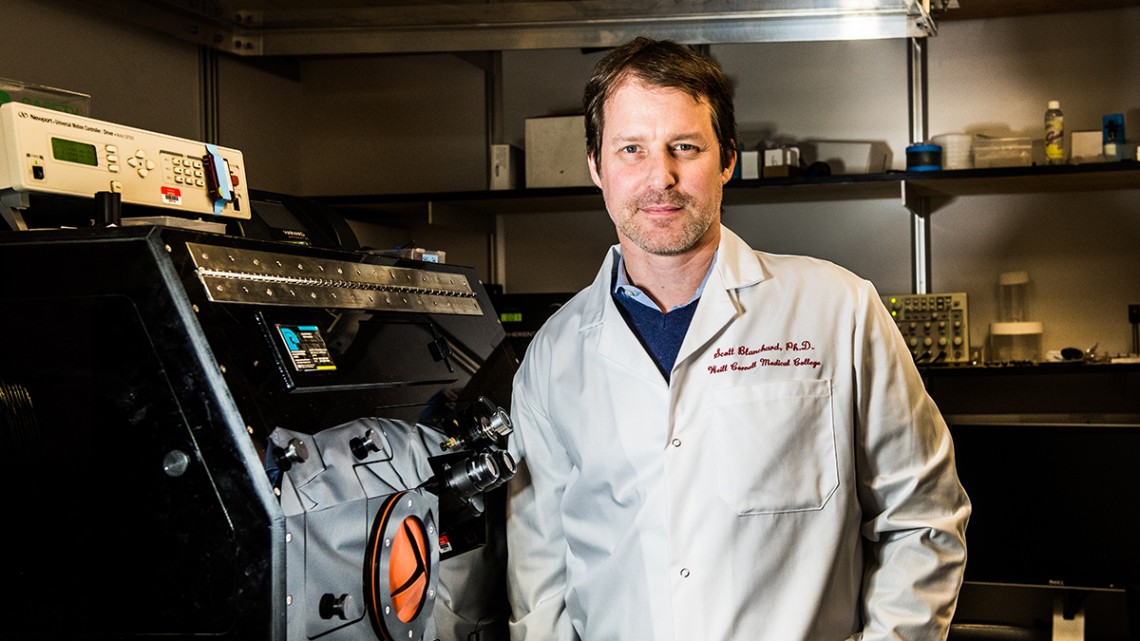
Scott Blanchard, professor of physiology and biophysics at Weill Cornell Medicine.
Genetic variation in cells' protein-building may have health implications
By Bridget Kuehn
The millions of cellular machines called ribosomes, which translate the genetic code carried by DNA into proteins, have long been thought to all be identical.
But new research from Weill Cornell Medicine scientists suggests that genetic variation in ribosomal RNA, the most essential component of the ribosome, may influence how much and which proteins are made. This finding could explain why ribosomal genes have been linked to developmental disorders.
In a paper published Feb. 28 in Science Advances, Scott Blanchard, a professor of physiology and biophysics at Weill Cornell Medicine, and colleagues analyzed ribosomal DNA (rDNA) from thousands of individuals. They discovered that each person actually contains a wide variety of ribosomes, upending the conventional wisdom that ribosomes are identical, akin to manufacturing plants with rows and rows of the same machines building the same product. They also found that rDNA sequences vary from one person to the next.
The investigators’ findings provide concrete evidence of pervasive variation in the ribosomal DNA genes that encode ribosomal RNA (rRNA). These genes have proved very difficult to analyze, and thereby constitute a largely unexplored area of the genome. The breakthroughs presented in their study suggest that genetic differences in rDNA may affect the way it builds proteins.
They also suggest that rDNA may add a layer of genetic regulation that may contribute to normal human development as well as diseases.
“Our analysis raises the possibility that the ribosome itself may be playing a role in tissue-specific gene expression,” Blanchard said. “This could help explain why cells in different organs develop differently even though they are believed to have identical DNA.”
Scientists have been aware of differences in the genes encoding rRNA among bacteria and more complex creatures since the 1980s, Blanchard said, but the consequences of those differences have remained unclear. Scientists have more recently begun to recognize that variations in the ribosome itself are linked to some developmental disorders, such as Diamond Black Fan Anemia, a condition that causes a shortage of red blood cells as well as head and facial abnormalities. Given that ribosomal RNA performs most of the ribosome’s essential catalytic functions and contributes to the ribosome’s interaction with cellular factors, the researchers speculate that distinct ribosomal DNA genes may contribute to human health and disease.
The investigators, including lead author Matthew Parks, a postdoctoral associate at Weill Cornell Medicine, found in individual mice that rRNA genes with different sequences were expressed at different levels in each organ.
“The ribosome population in the mouse brain, for instance, appears to be different than in the liver, lungs and ovaries,” Blanchard said. “This means that while a single organism may have an identical genome in each of these organs, they may be expressing ribosomes that contain different rRNA sequences.”
One potential implication of this finding is that the different ribosome populations may affect each organ’s function.
They also found genetic differences in ribosomes from different human populations, and evidence that the rDNA regions may be changing faster than other parts of the genome.
“The potential physiological impacts of physical distinctions in the rRNA sequence of the ribosome have not been investigated before,” Blanchard said. “It’s an overlooked aspect of modern genomics and medical diagnostics. Is it related to Alzheimer’s disease, heart disease or cancer? We just don’t know yet because no one has examined this possibility before.
“rDNA is currently dark matter in the genome,” he added. “It is essential that we investigate whether it is a significant contributor to human disease.”
Bridget Kuehn is a freelance writer for Weill Cornell Medicine.
Media Contact
Get Cornell news delivered right to your inbox.
Subscribe
